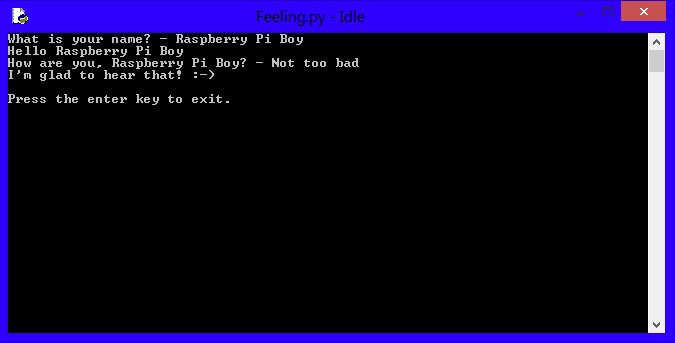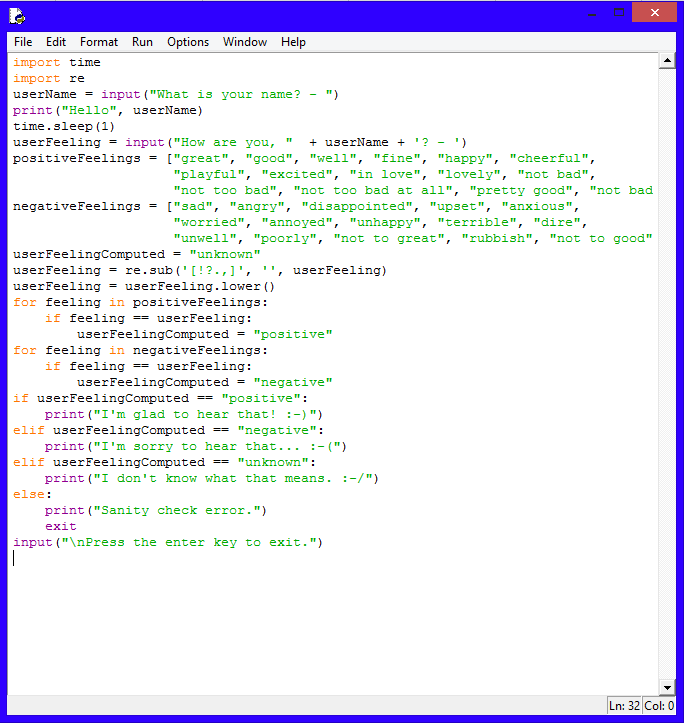Raspberry pi boy's Website
These are some of my python recipes:
This is a snake snake game using the python library pygame.
import pygame
# --- Globals ---
# Colors
BLACK = (0, 0, 0)
WHITE = (255, 255, 255)
# Set the width and height of each snake segment
segment_width = 15
segment_height = 15
# Margin between each segment
segment_margin = 3
# Set initial speed
x_change = segment_width + segment_margin
y_change = 0
class Segment(pygame.sprite.Sprite):
""" Class to represent one segment of the snake. """
# -- Methods
# Constructor function
def __init__(self, x, y):
# Call the parent's constructor
super().__init__()
# Set height, width
self.image = pygame.Surface([segment_width, segment_height])
self.image.fill(WHITE)
# Make our top-left corner the passed-in location.
self.rect = self.image.get_rect()
self.rect.x = x
self.rect.y = y
# Call this function so the Pygame library can initialize itself
pygame.init()
# Create an 800x600 sized screen
screen = pygame.display.set_mode([800, 600])
# Set the title of the window
pygame.display.set_caption('Snake Example')
allspriteslist = pygame.sprite.Group()
# Create an initial snake
snake_segments = []
for i in range(15):
x = 250 - (segment_width + segment_margin) * i
y = 30
segment = Segment(x, y)
snake_segments.append(segment)
allspriteslist.add(segment)
clock = pygame.time.Clock()
done = False
while not done:
for event in pygame.event.get():
if event.type == pygame.QUIT:
done = True
# Set the speed based on the key pressed
# We want the speed to be enough that we move a full
# segment, plus the margin.
if event.type == pygame.KEYDOWN:
if event.key == pygame.K_LEFT:
x_change = (segment_width + segment_margin) * -1
y_change = 0
if event.key == pygame.K_RIGHT:
x_change = (segment_width + segment_margin)
y_change = 0
if event.key == pygame.K_UP:
x_change = 0
y_change = (segment_height + segment_margin) * -1
if event.key == pygame.K_DOWN:
x_change = 0
y_change = (segment_height + segment_margin)
# Get rid of last segment of the snake
# .pop() command removes last item in list
old_segment = snake_segments.pop()
allspriteslist.remove(old_segment)
# Figure out where new segment will be
x = snake_segments[0].rect.x + x_change
y = snake_segments[0].rect.y + y_change
segment = Segment(x, y)
# Insert new segment into the list
snake_segments.insert(0, segment)
allspriteslist.add(segment)
# -- Draw everything
# Clear screen
screen.fill(BLACK)
allspriteslist.draw(screen)
# Flip screen
pygame.display.flip()
# Pause
clock.tick(5)
pygame.quit()
import pygame
# --- Globals ---
# Colors
BLACK = (0, 0, 0)
WHITE = (255, 255, 255)
# Set the width and height of each snake segment
segment_width = 15
segment_height = 15
# Margin between each segment
segment_margin = 3
# Set initial speed
x_change = segment_width + segment_margin
y_change = 0
class Segment(pygame.sprite.Sprite):
""" Class to represent one segment of the snake. """
# -- Methods
# Constructor function
def __init__(self, x, y):
# Call the parent's constructor
super().__init__()
# Set height, width
self.image = pygame.Surface([segment_width, segment_height])
self.image.fill(WHITE)
# Make our top-left corner the passed-in location.
self.rect = self.image.get_rect()
self.rect.x = x
self.rect.y = y
# Call this function so the Pygame library can initialize itself
pygame.init()
# Create an 800x600 sized screen
screen = pygame.display.set_mode([800, 600])
# Set the title of the window
pygame.display.set_caption('Snake Example')
allspriteslist = pygame.sprite.Group()
# Create an initial snake
snake_segments = []
for i in range(15):
x = 250 - (segment_width + segment_margin) * i
y = 30
segment = Segment(x, y)
snake_segments.append(segment)
allspriteslist.add(segment)
clock = pygame.time.Clock()
done = False
while not done:
for event in pygame.event.get():
if event.type == pygame.QUIT:
done = True
# Set the speed based on the key pressed
# We want the speed to be enough that we move a full
# segment, plus the margin.
if event.type == pygame.KEYDOWN:
if event.key == pygame.K_LEFT:
x_change = (segment_width + segment_margin) * -1
y_change = 0
if event.key == pygame.K_RIGHT:
x_change = (segment_width + segment_margin)
y_change = 0
if event.key == pygame.K_UP:
x_change = 0
y_change = (segment_height + segment_margin) * -1
if event.key == pygame.K_DOWN:
x_change = 0
y_change = (segment_height + segment_margin)
# Get rid of last segment of the snake
# .pop() command removes last item in list
old_segment = snake_segments.pop()
allspriteslist.remove(old_segment)
# Figure out where new segment will be
x = snake_segments[0].rect.x + x_change
y = snake_segments[0].rect.y + y_change
segment = Segment(x, y)
# Insert new segment into the list
snake_segments.insert(0, segment)
allspriteslist.add(segment)
# -- Draw everything
# Clear screen
screen.fill(BLACK)
allspriteslist.draw(screen)
# Flip screen
pygame.display.flip()
# Pause
clock.tick(5)
pygame.quit()
This is a prototype of one of my Artificial Intellegence programs I am planning to give python a thesaurus so python can tell if it is a synonym of a good feeling so if any one finds or knows of any good thesauruses tell me so that I can progress futher in this AI program. Also if any one is interested this particualar bit of AI use the prototype below as a starting point or template. I have this on git hub in my feelingsimulater repositery in github so go ahead and check it out my git hub at this location: https://www.github.com/raspberry-pi-boy

import time
import re
userName = input("What is your name? - ")
print("Hello", userName)
time.sleep(1)
userFeeling = input("How are you, " + userName + '? - ')
positiveFeelings = ["great", "good", "well", "fine", "happy", "cheerful",
"playful", "excited", "in love", "lovely", "not bad",
"not too bad", "not too bad at all", "pretty good",
"not bad thanks"]
negativeFeelings = ["sad", "angry", "disappointed", "upset", "anxious",
"worried", "annoyed", "unhappy", "terrible", "dire",
"unwell", "poorly", "not to great", "rubbish",
"not to good",]
userFeelingComputed = "unknown"
userFeeling = re.sub('[!?.,]', '', userFeeling)
userFeeling = userFeeling.lower()
for feeling in positiveFeelings:
if feeling == userFeeling:
userFeelingComputed = "positive"
for feeling in negativeFeelings:
if feeling == userFeeling:
userFeelingComputed = "negative"
if userFeelingComputed == "positive":
print("I'm glad to hear that! :-)")
elif userFeelingComputed == "negative":
print("I'm sorry to hear that... :-(")
elif userFeelingComputed == "unknown":
print("I don't know what that means. :-/")
else:
print("Sanity check error.")
exit
input("\nPress the enter key to exit.")
import time
import re
userName = input("What is your name? - ")
print("Hello", userName)
time.sleep(1)
userFeeling = input("How are you, " + userName + '? - ')
positiveFeelings = ["great", "good", "well", "fine", "happy", "cheerful",
"playful", "excited", "in love", "lovely", "not bad",
"not too bad", "not too bad at all", "pretty good",
"not bad thanks"]
negativeFeelings = ["sad", "angry", "disappointed", "upset", "anxious",
"worried", "annoyed", "unhappy", "terrible", "dire",
"unwell", "poorly", "not to great", "rubbish",
"not to good",]
userFeelingComputed = "unknown"
userFeeling = re.sub('[!?.,]', '', userFeeling)
userFeeling = userFeeling.lower()
for feeling in positiveFeelings:
if feeling == userFeeling:
userFeelingComputed = "positive"
for feeling in negativeFeelings:
if feeling == userFeeling:
userFeelingComputed = "negative"
if userFeelingComputed == "positive":
print("I'm glad to hear that! :-)")
elif userFeelingComputed == "negative":
print("I'm sorry to hear that... :-(")
elif userFeelingComputed == "unknown":
print("I don't know what that means. :-/")
else:
print("Sanity check error.")
exit
input("\nPress the enter key to exit.")
